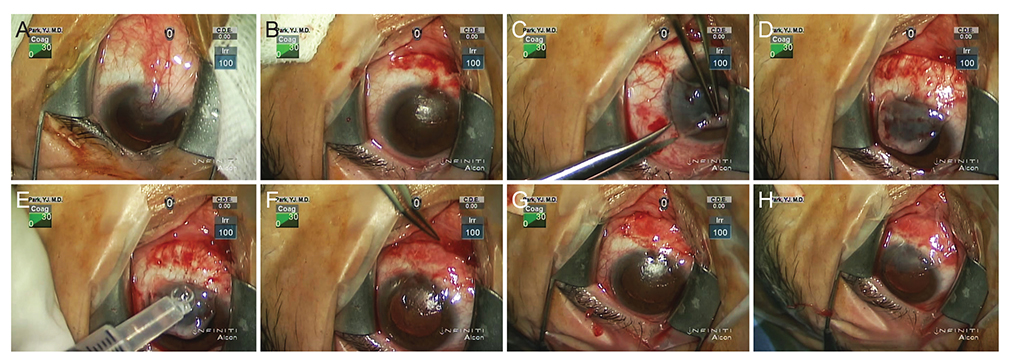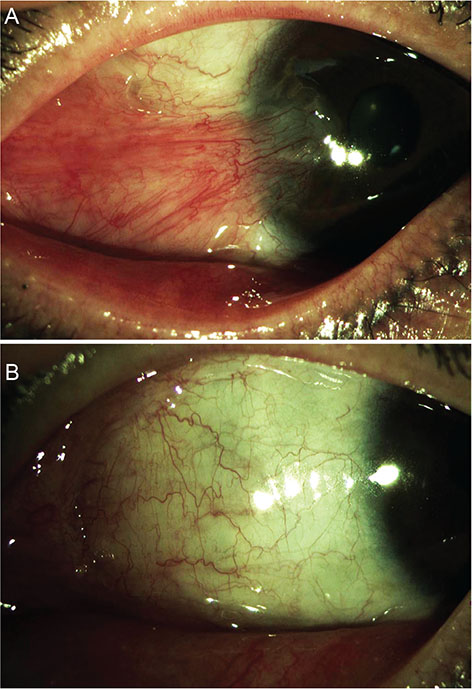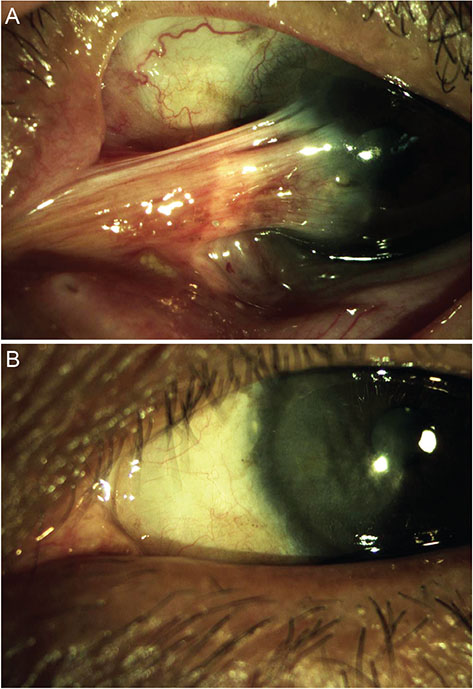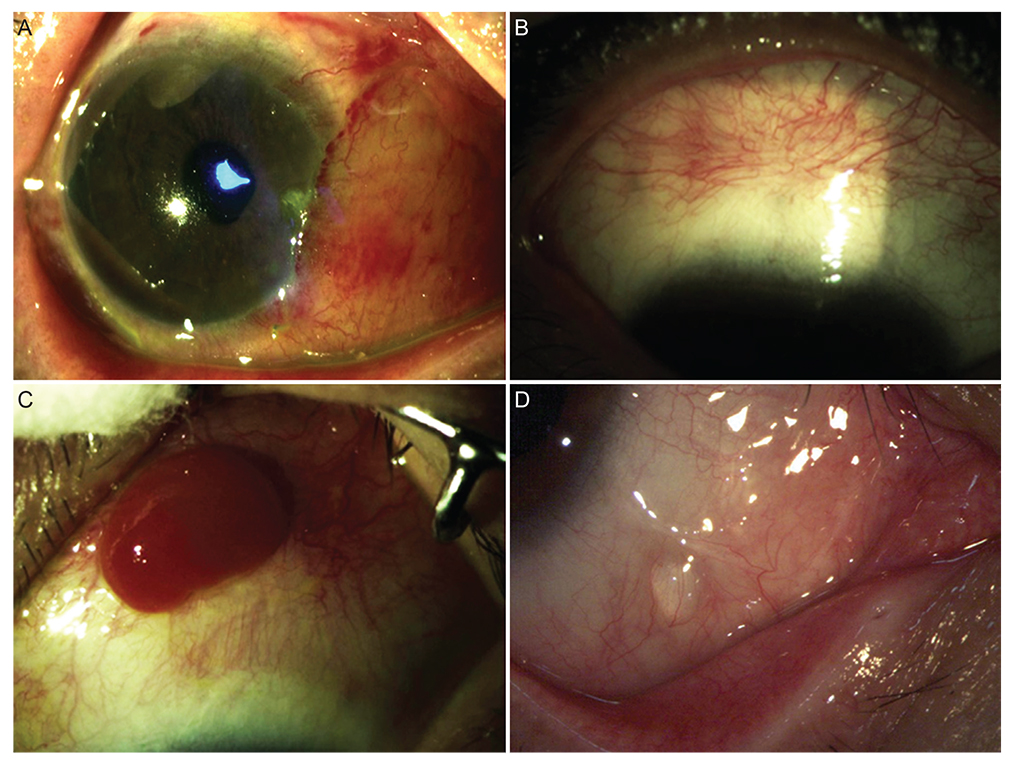Korean J Ophthalmol.
2017 Dec;31(6):469-478. 10.3341/kjo.2016.0135.
Efficacy and Safety of a Large Conjunctival Autograft for Recurrent Pterygium
- Affiliations
-
- 1Cheil Eye Hospital, Daegu, Korea. eyepark9@naver.com
- 2Yonsei Jeil Eye Clinic, Daegu, Korea.
- KMID: 2396697
- DOI: http://doi.org/10.3341/kjo.2016.0135
Abstract
- PURPOSE
To evaluate the efficacy and safety of pterygium excision using a large conjunctival autograft for the treatment of recurrent pterygium.
METHODS
The medical records of 120 patients (126 eyes) with recurrent pterygium were reviewed. For each affected eye, pterygium excision with a large conjunctival autograft was performed. The graft was harvested from the superior bulbar area and measured more than 8 × 10 mm in size. Only patients who completed at least six months of follow-up were included. Postoperative clinical outcomes, recurrence rate, and complications were analyzed. Patients with any evidence of recurrence after surgery received a subconjunctival bevacizumab injection.
RESULTS
The average patient age was 56.5 ± 10.2 years, and 45 out of 120 patients were male. The mean study follow-up period was 17.7 ± 17.6 months. Most patients were satisfied with the cosmetic outcome. Postoperative visual acuity improved from 0.69 to 0.75 (p < 0.05). Postoperative refractive astigmatism and corneal astigmatism decreased by 0.55 and 2.73 diopters, respectively (p < 0.05). The postoperative recurrence rate was 4.0%, and the average recurrence period was 7.4 ± 0.6 weeks. A subconjunctival injection of 5 mg bevacizumab was performed in cases of recurrence; no progression of the pterygium was observed following the injection. Postoperative complications included 2 cases of conjunctival graft edema in 2 eyes, 5 donor site scars in 5 eyes, 13 pyogenic granulomas in 13 eyes, and a conjunctival epithelial inclusion cyst in 7 eyes.
CONCLUSIONS
Pterygium excision with a large conjunctival autograft for the treatment of recurrent pterygium produced an excellent cosmetic outcome, a low recurrence rate, and minimal complications. A subconjunctival bevacizumab injection given in cases of recurrence following surgery might be effective in preventing progression of the pterygium.
Keyword
MeSH Terms
Figure
Reference
-
1. Yoon KC, Mun GH, Kim SD, et al. Prevalence of eye diseases in South Korea: data from the Korea National Health and Nutrition Examination Survey 2008-2009. Korean J Ophthalmol. 2011; 25:421–433.2. Wong WW. A hypothesis on the pathogenesis of pterygiums. Ann Ophthalmol. 1978; 10:303–308.3. Coroneo MT. Pterygium as an early indicator of ultraviolet insolation: a hypothesis. Br J Ophthalmol. 1993; 77:734–739.4. Zauberman H. Pterygium and its recurrence. Am J Ophthalmol. 1967; 63:1780–1786.5. Youngson RM. Recurrence of pterygium after excision. Br J Ophthalmol. 1972; 56:120–125.6. Hirst LW. Prospective study of primary pterygium surgery using pterygium extended removal followed by extended conjunctival transplantation. Ophthalmology. 2008; 115:1663–1672.7. Kucukerdonmez C, Akova YA, Altinors DD. Comparison of conjunctival autograft with amniotic membrane transplantation for pterygium surgery: surgical and cosmetic outcome. Cornea. 2007; 26:407–413.8. Tananuvat N, Martin T. The results of amniotic membrane transplantation for primary pterygium compared with conjunctival autograft. Cornea. 2004; 23:458–463.9. Shimazaki J, Kosaka K, Shimmura S, Tsubota K. Amniotic membrane transplantation with conjunctival autograft for recurrent pterygium. Ophthalmology. 2003; 110:119–124.10. Ti SE, Chee SP, Dear KB, Tan DT. Analysis of variation in success rates in conjunctival autografting for primary and recurrent pterygium. Br J Ophthalmol. 2000; 84:385–389.11. Kaufman SC, Jacobs DS, Lee WB, et al. Options and adjuvants in surgery for pterygium: a report by the American Academy of Ophthalmology. Ophthalmology. 2013; 120:201–208.12. Tan DT, Chee SP, Dear KB, Lim AS. Effect of pterygium morphology on pterygium recurrence in a controlled trial comparing conjunctival autografting with bare sclera excision. Arch Ophthalmol. 1997; 115:1235–1240.13. Ha SW, Park JH, Shin IH, Kim HK. Clinical analysis of risk factors contributing to recurrence of pterygium after excision and graft surgery. Int J Ophthalmol. 2015; 8:522–527.14. Koranyi G, Artzen D, Seregard S, Kopp ED. Intraoperative mitomycin C versus autologous conjunctival autograft in surgery of primary pterygium with four-year follow-up. Acta Ophthalmol. 2012; 90:266–270.15. Ozer A, Yildirim N, Erol N, Yurdakul S. Long-term results of bare sclera, limbal-conjunctival autograft and amniotic membrane graft techniques in primary pterygium excisions. Ophthalmologica. 2009; 223:269–273.16. Luanratanakorn P, Ratanapakorn T, Suwan-Apichon O, Chuck RS. Randomised controlled study of conjunctival autograft versus amniotic membrane graft in pterygium excision. Br J Ophthalmol. 2006; 90:1476–1480.17. Fallah MR, Golabdar MR, Amozadeh J, et al. Transplantation of conjunctival limbal autograft and amniotic membrane vs mitomycin C and amniotic membrane in treatment of recurrent pterygium. Eye (Lond). 2008; 22:420–424.18. Ma DH, See LC, Hwang YS, Wang SF. Comparison of amniotic membrane graft alone or combined with intraoperative mitomycin C to prevent recurrence after excision of recurrent pterygia. Cornea. 2005; 24:141–150.19. Kim YI, Lee GY, Kim EJ, et al. The effect of subconjunctival bevacizumab injection before conjunctival autograft for pterygium. J Korean Ophthalmol Soc. 2015; 56:847–855.20. Stival LR, Lago AM, Figueiredo MN, et al. Efficacy and safety of subconjunctival bevacizumab for recurrent pterygium. Arq Bras Oftalmol. 2014; 77:4–7.21. Hu Q, Qiao Y, Nie X, et al. Bevacizumab in the treatment of pterygium: a meta-analysis. Cornea. 2014; 33:154–160.22. Ozgurhan EB, Agca A, Kara N, et al. Topical application of bevacizumab as an adjunct to recurrent pterygium surgery. Cornea. 2013; 32:835–838.23. Hurmeric V, Vaddavalli P, Galor A, et al. Single and multiple injections of subconjunctival ranibizumab for early, recurrent pterygium. Clin Ophthalmol. 2013; 7:467–473.24. Alhammami H, Farhood Q, Shuber H. Subconjunctival bevacizumab injection in treatment of recurrent pterygium. J Clin Exp Ophthalmol. 2013; 01. 23. DOI: 10.4172/2155-9570.1000267.25. Lekhanont K, Patarakittam T, Thongphiew P, et al. Randomized controlled trial of subconjunctival bevacizumab injection in impending recurrent pterygium: a pilot study. Cornea. 2012; 31:155–161.26. Mandalos A, Tsakpinis D, Karayannopoulou G, et al. The effect of subconjunctival ranibizumab on primary pterygium: a pilot study. Cornea. 2010; 29:1373–1379.27. Fallah MR, Khosravi K, Hashemian MN, et al. Efficacy of topical bevacizumab for inhibiting growth of impending recurrent pterygium. Curr Eye Res. 2010; 35:17–22.28. Nava-Castaneda A, Ulloa-Orozco I, Garnica-Hayashi L, et al. Triple subconjunctival bevacizumab injection for early corneal recurrent pterygium: one-year follow-up. J Ocul Pharmacol Ther. 2015; 31:106–113.29. Safianik B, Ben-Zion I, Garzozi HJ. Serious corneoscleral complications after pterygium excision with mitomycin C. Br J Ophthalmol. 2002; 86:357–358.30. Dougherty PJ, Hardten DR, Lindstrom RL. Corneoscleral melt after pterygium surgery using a single intraoperative application of mitomycin-C. Cornea. 1996; 15:537–540.31. Bahar I, Kaiserman I, Lange AP, et al. The effect of mitomycin C on corneal endothelium in pterygium surgery. Am J Ophthalmol. 2009; 147:447–452.32. Kheirkhah A, Izadi A, Kiarudi MY, et al. Effects of mitomycin C on corneal endothelial cell counts in pterygium surgery: role of application location. Am J Ophthalmol. 2011; 151:488–493.33. Avisar R, Apel I, Avisar I, Weinberger D. Endothelial cell loss during pterygium surgery: importance of timing of mitomycin C application. Cornea. 2009; 28:879–881.34. Prabhasawat P, Barton K, Burkett G, Tseng SC. Comparison of conjunctival autografts, amniotic membrane grafts, and primary closure for pterygium excision. Ophthalmology. 1997; 104:974–985.35. Solomon A, Pires RT, Tseng SC. Amniotic membrane transplantation after extensive removal of primary and recurrent pterygia. Ophthalmology. 2001; 108:449–460.36. Kim HH, Mun HJ, Park YJ, et al. Conjunctivolimbal autograft using a fibrin adhesive in pterygium surgery. Korean J Ophthalmol. 2008; 22:147–154.37. Fernandes M, Sangwan VS, Bansal AK, et al. Outcome of pterygium surgery: analysis over 14 years. Eye (Lond). 2005; 19:1182–1190.38. Kria L, Ohira A, Amemiya T. TNP-470 (a fungus-derived inhibitor of angiogenesis) reduces proliferation of cultured fibroblasts isolated from primary pterygia: a possible drug therapy for pterygia. Curr Eye Res. 1998; 17:986–993.39. Kria L, Ohira A, Amemiya T. Growth factors in cultured pterygium fibroblasts: immunohistochemical and ELISA analysis. Graefes Arch Clin Exp Ophthalmol. 1998; 236:702–708.40. Barishak RY, Baruh E, Lazar M. Episcleral traumatic conjunctival inclusion cyst. Br J Ophthalmol. 1977; 61:299–301.41. Song JJ, Finger PT, Kurli M, et al. Giant secondary conjunctival inclusion cysts: a late complication of strabismus surgery. Ophthalmology. 2006; 113:1049.42. Williams BJ, Durcan FJ, Mamalis N, Veiga J. Conjunctival epithelial inclusion cyst. Arch Ophthalmol. 1997; 115:816–817.43. Gebhardt M, Mentlein R, Schaudig U, et al. Differential expression of vascular endothelial growth factor implies the limbal origin of pterygia. Ophthalmology. 2005; 112:1023–1030.44. Jin J, Guan M, Sima J, et al. Decreased pigment epithelium-derived factor and increased vascular endothelial growth factor levels in pterygia. Cornea. 2003; 22:473–477.45. Marcovich AL, Morad Y, Sandbank J, et al. Angiogenesis in pterygium: morphometric and immunohistochemical study. Curr Eye Res. 2002; 25:17–22.46. Lee DH, Cho HJ, Kim JT, et al. Expression of vascular endothelial growth factor and inducible nitric oxide synthase in pterygia. Cornea. 2001; 20:738–742.
- Full Text Links
- Actions
-
Cited
- CITED
-
- Close
- Share
- Similar articles
-
- The Treatment of Esodeviation with Abduction Deficiency Caused by Recurrent Pterygium
- Recurrence Rates of Conjunctival Autograft Transplantation With Aminiotic Membrane Transplantation in Primary Pterygium Surgery
- Efficacy of Subconjunctival Bevacizumab Injection after Pterygium Excision with Limbal Conjunctival Autograft in Recurred Pterygium
- The Clinical Efficacy of Amniotic Membrane Transplantation and Limbal-Conjunctival Autograft in Patients with Recurrent Pterygium or Pseudopterygium
- Surgical Outcome of Primary Pterygium Excision with Conjunctival Autograft






